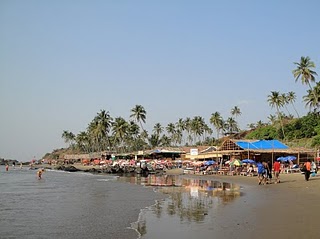January 6, 2010: Goa, India
I’ve arrived in Goa, the legendary summer place on the southwestern shores of India. I made the bold decision while in Varanasi, and with unstoppable determination I began laying the groundwork for my flight from coldness to Goa.
For three months now I’ve been cold. Shortly after arriving in Nepal I realized I’d need some warmer clothes. Since then I’ve been wearing my second skin of thermals and down—I sleep with all my clothes on and I spend all my days freezing my ass off, despite my ridiculous puffy blue down Michelin Goodyear jacket. My jacket is the butt of many jokes and has become quite filthy, but I can’t imagine life without it. I’ve been seeking comfort and was aware that decisive action was necessary if I were to escape the winter of northern India and Nepal.
Of course, I knew I had to go south. But I haven’t found my groove in India yet. The country is so huge, I feel disoriented and overwhelmed by possibilities. I hear many intriguing stories of interesting places, but every destination requires a serious commitment in India. The only thing I felt sure about was that Goa had nice beaches and was summery. That’s all I needed to know.
After the standard dizzying adventure of various transports, including rickshaws, taxis, a 15-hour long train ride to Delhi, and more taxis, I hopped on a flight to Goa. The flight was two hours long, during which time I intently studied Lonely Planet trying to figure out what I would do once the plane landed. Nothing was clear to me, though. I felt like I was gonna puke, hadn’t slept in a very long time, my head was cloudy, and I was concerned about the amount of effort that was required of me before I would reach solace. Two Russian girls were sitting beside me on the plane, and after chatting for a little while they told me they were headed to Vagator and invited me to share a taxi with them. Problem solved.
I arrived feeling half dead, paid too much for a beach hut, crawled into bed, and slept for the next fourteen hours.
When I awoke the sun was shining brightly, casting speckles of sunlight on the walls of my bamboo hut. It was warm, it was nice. I grabbed my book and headed on down to the beach to explore and see where I’d arrived.
was shining brightly, casting speckles of sunlight on the walls of my bamboo hut. It was warm, it was nice. I grabbed my book and headed on down to the beach to explore and see where I’d arrived.
My hut was set upon a cliff that looked down upon the beach lined with banana plantations, coconut trees, and temporary bamboo restaurants. It was a beautiful summer day and the ocean wind blowing through my hair felt heavenly. I hobbled on down the rocky hill to the beach and found a nice beach chair with a sun umbrella overhead.
It was still early, but as the day progressed I quickly began to figure out what was happening. First thing that struck me was how many Russians vacation here. Indeed, it felt like I was in little Russia. Second observation: techno is the beloved music here and is blasting out of speakers at all hours of the day. Third: everyone is drinking and rolling hash cigarettes morning noon and night. I had arrived in India’s famed party destination.
The beach is an endless strip of restaurants and bars—all of them are crowded with Russians and dreadlocked hippies lounging on beach chairs. Smoking and drinking all day long, these types don’t seem to really be the backpacker-types, but rather the fun-loving types seeking endless summer. As I look around I sense that many of these people have been here for a very long time.
It is nice here, but is not really my style. I realized that soon after arriving, but was ok with that because it fit my needs perfectly. For me, this is a retreat, as I seek refuge in summer’s grace. I lay peaceful in sunlight, melting in this blessed warmth, eating occasionally.
I have spoken so few words lately that I don’t even bother to wear my hearing aids. This is my silent meditation. I see around me large groups of English and Australians, Germans, and Russians drinking, laughing and rolling cigarette after cigarette. I think they are probably having more fun than me, but I don’t wish to join them. Occasionally I step out of this silent place and reach out to someone, but they are usually Russians that don’t speak any English, and so with a friendly shrug and a smile, we agree to remain strangers.
The few people I have met here all seem quite eccentric, and definitely fit in the alternative category. There was a 51-year-old French guy I met who was sitting near me in a little G-string bikini bottom. He was ardently sanding a piece of sandalwood for hours, which intrigued me and inspired me to approach him. He explained it was a box to store his hash, and then in his very-French accent launched into conspiracy theories about the Indian police, and how they are undercover and arresting hash smokers here and killing the Goa scene, where he’s been living for the past 35 years.
Naturally drawn to hippies, I have reached out to a few, but have been surprised by my experiences. The hippies here—they are hardcore hippies that make most Deadheads look like wealthy fraternity boys. Their dreads are enormous—and they are very proud of them. Most of them that I have met, however, seem very lost and angry. I feel no kinship and rarely see them smile. The new modern hippie seems to be a sad sort, finding their identity in dreads, piercing, tattoos and hash-cigarettes. I don’t see much spiritual inclination, nor do I feel that wonderful liberating come-as-you-are mentality that always made the Dead family so warm and encouraging. Instead, it’s a dark energy that repels me.
I rented a scooter for the week like every other tourist in the area. At first I was timid and had to keep reminding myself that in India you drive on the left side of the side of the road. Soon, however, I was buzzing around here there and everywhere, enjoying the wind through my hair and seeing how fast these things can go. My favorite place to go to is a hill overlooking Anjuna. I go there at sunset with a nice cold 20oz of Kingfisher and enjoy these moments immensely. The ride down the mountains through darkness is tricky, but it’s not too far and I take it slowly.
The Russians here are quite a spectacle. I am fully aware of the folly of making generalizations, but here in Goa I feel secure in saying every Russian guy is a bodybuilder. These guys are huge—enormous, powerful types, and they wear these funny banana hammock swimsuits. Their girlfriends—most of them seem to be petite vipers with skimpy-to-none bathing suits and seem fit for swimsuit edition magazines. I was sitting on the beach minding my own business when all of a sudden I’d look up and see a photo shoot underway. Needless to say, I was significantly distracted but enjoyed watching their lusty poses.
Side note: I’ve been told that it’s common for these Russian “couples” to go on vacation, and that what’s really happening is the guy pimps his “girlfriend” out. Unconfirmed rumour, possibly…
Nighttime here is all techno. Raves are the craze, as are Extasy and other pharmaceutical drugs. I went to Nine Bar, the most popular bar in Vagator, after sunset to check out the situation. The place was a great venue—a large outdoor space that overlooks the ocean and is lined with candles and coconut trees. Talking with a couple dudes swaying to the groove, I learned that “Goa Trance” is a popular genre of techno music that was born here. I wasn’t much impressed with it, though. It’s a constant in-your-face drumbeat, oscillating whirring of wind, and occasional abrasive sound effects. Nobody seemed to be all that into it though, so maybe I just caught a lame night. There was talk of an all night rave happening down the road later on in the week, which intrigued me but not enough to make me go there.
I feel I should go. This isn’t my summer home. This isn’t the beach I know and love. It is a European perversion of something that used to be unique and Indian. Today, there are no Indians here, except the ones bringing us beers or the ones that disturb my peace, trying to sell me DVDs, bongos and beach towels. These wandering vendors walk back and forth in mobs up and down the sandy stretch—they arrive every 30 seconds and get right in your face until you either lose your temper and say some things you wish you hadn’t, or you succumb and buy something. I regret that these vendors taught me that the only way to deal with them is to ignore them—which inspires much tension in my heart to treat anyone like that, but it was either that, or spend the next twenty minutes trying to convince them I wasn’t interested in buying their crap.

 was shining brightly, casting speckles of sunlight on the walls of my bamboo hut. It was warm, it was nice. I grabbed my book and headed on down to the beach to explore and see where I’d arrived.
was shining brightly, casting speckles of sunlight on the walls of my bamboo hut. It was warm, it was nice. I grabbed my book and headed on down to the beach to explore and see where I’d arrived.